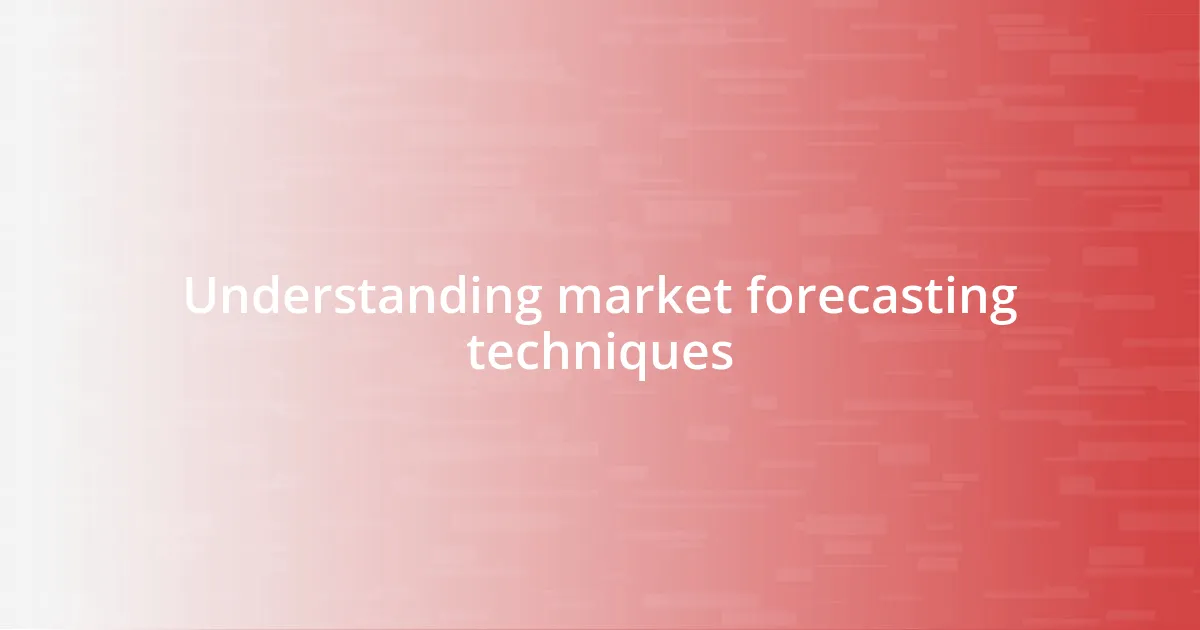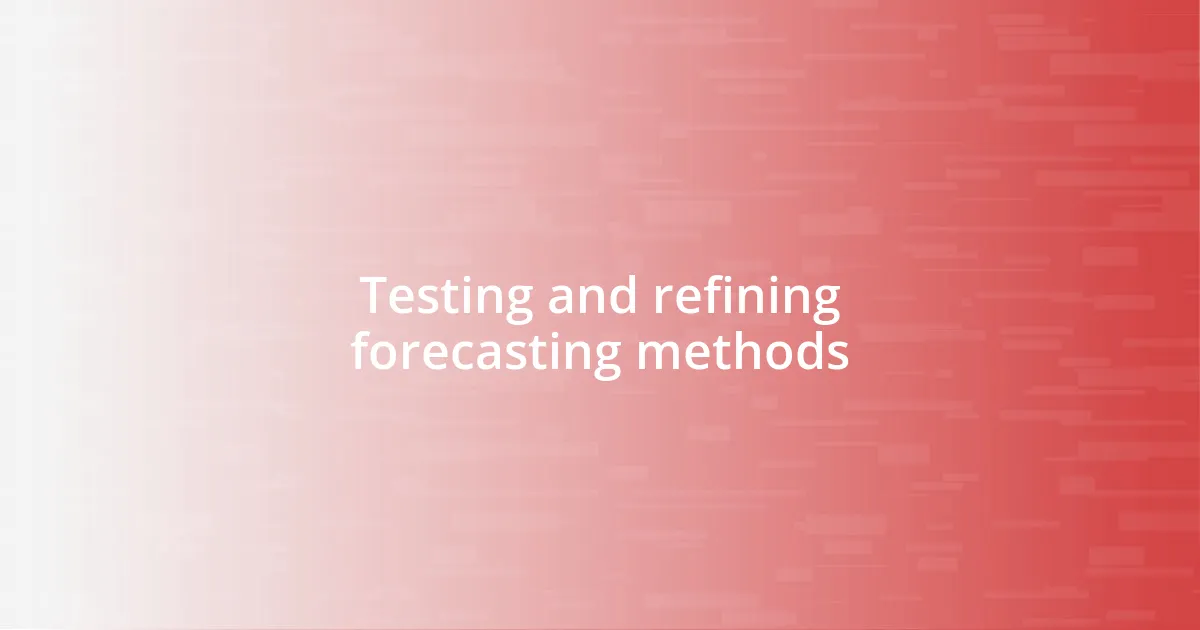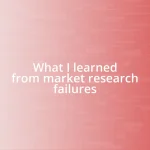Key takeaways:
- Combining quantitative and qualitative methods, such as historical data analysis and consumer sentiment, provides a comprehensive understanding of market trends.
- Identifying key market indicators like consumer confidence and unemployment rates is essential for making informed predictions about consumer behavior and market shifts.
- Continuous testing, refining forecasting methods, and adapting strategies based on feedback and changing market conditions enhance forecasting accuracy.
- Effectively applying forecasting results through visual aids and stakeholder communication fosters collaboration and ensures alignment towards common goals.

Understanding market forecasting techniques
Market forecasting techniques can be quite diverse, and that’s what I find fascinating. For instance, I often rely on a blend of quantitative and qualitative analysis. I remember one project where I meticulously gathered historical sales data, only to realize that my gut feeling about emerging trends was equally powerful. Have you ever felt the same pull between numbers and instinct?
When it comes to qualitative techniques, I value consumer sentiment analysis a lot. Understanding what people are feeling about a product can sometimes be the game-changer. I recall analyzing social media conversations during a product launch, and it was eye-opening—people’s emotions shaped their purchasing decisions more than any chart could show. Isn’t it intriguing how emotions can steer market direction?
Additionally, collaborating with teams and sharing insights often brings unexpected clarity. I cherish those brainstorming sessions where we dissect market trends together. Sometimes, just hearing a colleague’s perspective can illuminate angles I hadn’t considered before. Have you ever had an “aha moment” in a discussion that shifted your entire outlook on a forecast?

Analyzing historical market data
Analyzing historical market data is like piecing together a puzzle. I often find myself sifting through past sales figures, looking for patterns and trends that hint at future performance. For instance, during a previous analysis, I noticed a significant spike in sales every fall for a specific product. This realization not only informed my strategy but also ignited my curiosity about seasonal influences on consumer behavior. Have you ever discovered a surprising trend in your data?
I’ve learned that the context surrounding historical data is crucial. It’s not enough to simply observe the numbers; understanding economic events or market shifts that coincided with certain trends can provide deeper insights. I remember a project where I had to correlate a sudden drop in sales with changes in regulation. Recognizing this connection not only helped me adjust forecasts but also made me appreciate how external factors often shape market dynamics. What context have you found valuable in your analysis?
Through my experiences, I’ve come to appreciate the power of visualizing historical data. I recall creating interactive charts to track changes over time, allowing me to share these insights easily with my team. The ability to present data visually transformed our discussions, as team members could instantly grasp complex trends. It’s fascinating how effective visualization can turn raw data into compelling narratives. How do you visualize your data for impactful storytelling?
| Aspect | Details |
|---|---|
| Trend Identification | Recognizing patterns in historical data helps anticipate future market shifts. |
| Contextual Understanding | Analyzing external factors enhances the accuracy of market predictions. |
| Data Visualization | Effective visuals can make complex data accessible and engaging. |

Identifying key market indicators
Identifying key market indicators requires a mix of intuition and data analysis. One indicator I often lean on is consumer confidence. I remember a time when a significant drop in consumer sentiment led to a noticeable decline in sales for our products. It’s fascinating how a shift in public perception can ripple through the market. Similarly, tracking employment rates has opened my eyes to potential spending habits. When people feel secure in their jobs, they tend to spend more, which is crucial for forecasting.
Here are some indicators I prioritize in my analysis:
- Consumer Confidence Index (CCI): A crucial gauge of how optimistic consumers are regarding the economy.
- Unemployment Rate: It significantly influences spending patterns and market demand.
- Retail Sales Data: Reflects consumer spending habits and serves as a direct indicator of economic health.
- Stock Market Performance: Often acts as a barometer for business confidence and can influence consumer behavior.
- Interest Rates: They affect borrowing costs and impact consumer and business spending decisions.
By closely monitoring these indicators, I believe I can make more informed predictions about where the market is headed. The interplay of these elements often creates a vibrant tapestry of insights that drive decision-making. It’s like having a compass that helps navigate through uncertainty. Have you found certain indicators that resonate with your forecasting journey?

Utilizing qualitative forecasting methods
Utilizing qualitative forecasting methods has been a game-changer in my forecasting toolkit. I remember once sitting in a brainstorming session with my team, where we relied heavily on expert opinions and customer interviews. The insights we gathered not only filled gaps left by quantitative data but also tapped into the motivations and sentiments of our target audience. Have you ever had a conversation with a customer that changed your perspective on their needs?
I often find that focus groups offer invaluable qualitative insights. In one project, we organized a few sessions and were able to observe firsthand how potential customers reacted to our product concepts. The feedback was illuminating, guiding us to refine our offerings based on real emotions and opinions rather than pure numbers. It made me realize that sometimes, human stories behind the data are what truly drive effective decision-making. Have you tried involving customers in your forecasting process?
Incorporating qualitative methods also allows me to adapt my strategies fluidly. Take market changes or emerging trends, for example. When I hear a recurring theme in customer feedback, I prioritize those insights, often leading to timely adjustments in our marketing strategies. By staying attuned to the voices of consumers, I can often anticipate shifts in market demands before they become visible in hard data. What do you think is the best method for gathering qualitative insights in your analyses?

Implementing quantitative forecasting models
Implementing quantitative forecasting models can seem daunting at first, but I’ve found it incredibly rewarding. In my experience, leveraging time series analysis has been pivotal. I recall a project where we analyzed historical sales data over several years to identify seasonal trends. This approach illuminated patterns I hadn’t noticed before, allowing me to make informed predictions about future sales during peak seasons. Isn’t it fascinating how past performance can shape future expectations?
The integration of regression analysis further enhances my forecasting accuracy. One especially memorable instance involved using regression to assess how changes in marketing spend affected sales. By establishing a clear relationship between investment and return, I not only justified our budget to stakeholders but also optimized our future marketing strategies. Have you ever used regression to uncover hidden relationships in your data? It can truly reshape your understanding of what drives your business.
Lastly, I can’t emphasize enough the importance of data validation in this process. After implementing a model, I routinely check its forecasts against actual outcomes. This not only builds confidence in my approach but also helps refine the model for better accuracy. It’s like tuning a musical instrument—each adjustment creates a clearer and more harmonious prediction. How do you ensure your quantitative models remain reliable? I believe constant evaluation is the key to mastering market forecasting.

Testing and refining forecasting methods
I’ve discovered that testing and refining forecasting methods is an ongoing journey, rather than a one-time event. For instance, after implementing a new forecast model, I make it a point to run that model against different datasets. Early on, I remember stumbling upon data anomalies that sent my predictions off course. These insights ignited a deeper curiosity in me—how often does our data mislead us if we fail to double-check it?
Adjusting and refining my methods based on feedback is crucial. I once conducted a post-implementation review with my team after a product launch to examine our forecasts versus actual sales. The conversations were eye-opening, revealing several assumptions we held that didn’t align with market reality. Often, these discussions spark ideas for new metrics to incorporate. Can you think of a time when team input reshaped your forecasts? It’s a poignant reminder that collaboration can unveil layers of insight we might overlook on our own.
Furthermore, I frequently revisit my forecasting techniques as market conditions evolve. I recall a project where the consumer behavior swiftly changed due to emerging technologies. By continuously testing my methods, I was able to pivot quickly, refining my approach to align with the new landscape. It’s these moments that emphasize the importance of adaptability. How responsive are you to shifts in your forecasting methods? I believe that remaining flexible keeps us ahead in this challenging field.

Applying forecasting results effectively
I find that the true art of applying forecasting results effectively lies in translating those numbers into actionable strategies. In one of my earlier roles, I remember presenting a quarterly forecast to my team and being puzzled when they seemed more focused on the details than on the insights. It hit me then—how can we make our forecasts resonate? I began incorporating visual aids, like graphs and charts, which not only clarified our goals but also sparked engaging discussions around our projections. Have you ever tried using visuals to enhance understanding in your own presentations?
Another critical aspect is stakeholder communication. I once worked on a project forecasting a new product launch with ambitious sales goals. After assessing potential demand, I gathered key stakeholders to walk them through the results in a storytelling format. This approach empowered all parties involved. Rather than seeing the numbers as abstract metrics, they recognized them as part of our collective journey. Isn’t it empowering when everyone is on the same page and contributing toward a common goal?
Lastly, I’ve learned that monitoring and iterating based on the results is vital after applying forecasting insights. Early in my career, I underestimated the need for this feedback loop. But after experiencing a significant sales drop despite a strong forecast, I realized my oversight. Tracking not just the numbers but the market responses led to valuable lessons. Now, I routinely check how our forecasts align with real-world performance, which sparks not only curiosity but also a commitment to continuous learning. How often do you reassess your forecasts against actual outcomes? For me, it’s become an essential practice in refining my strategies.















